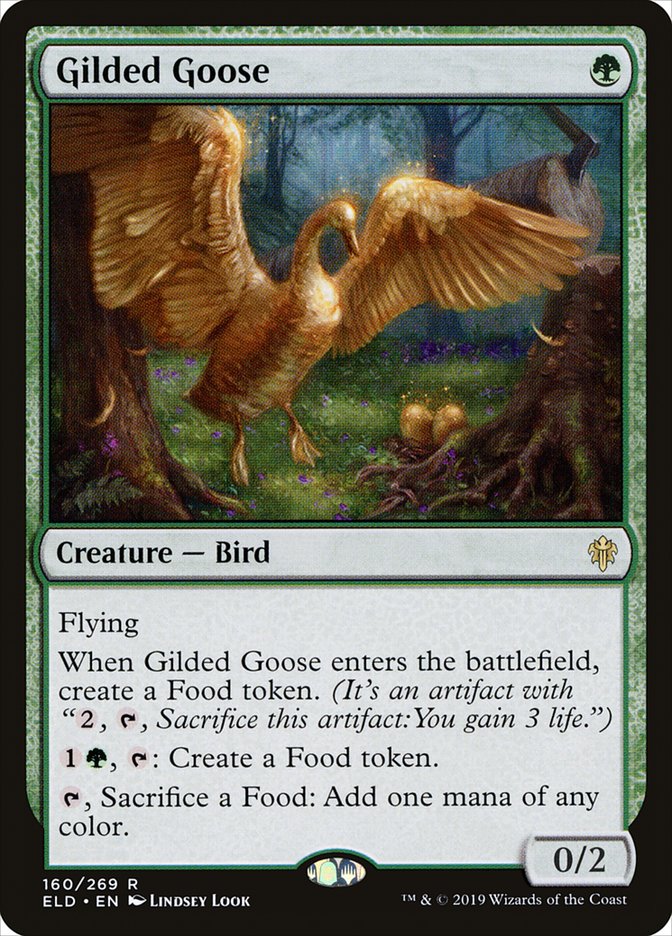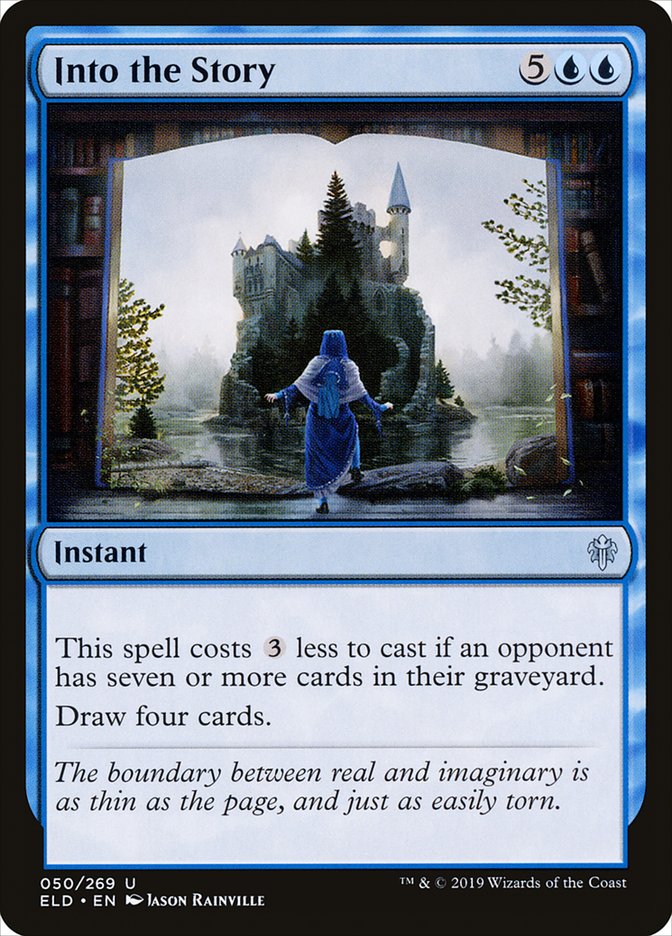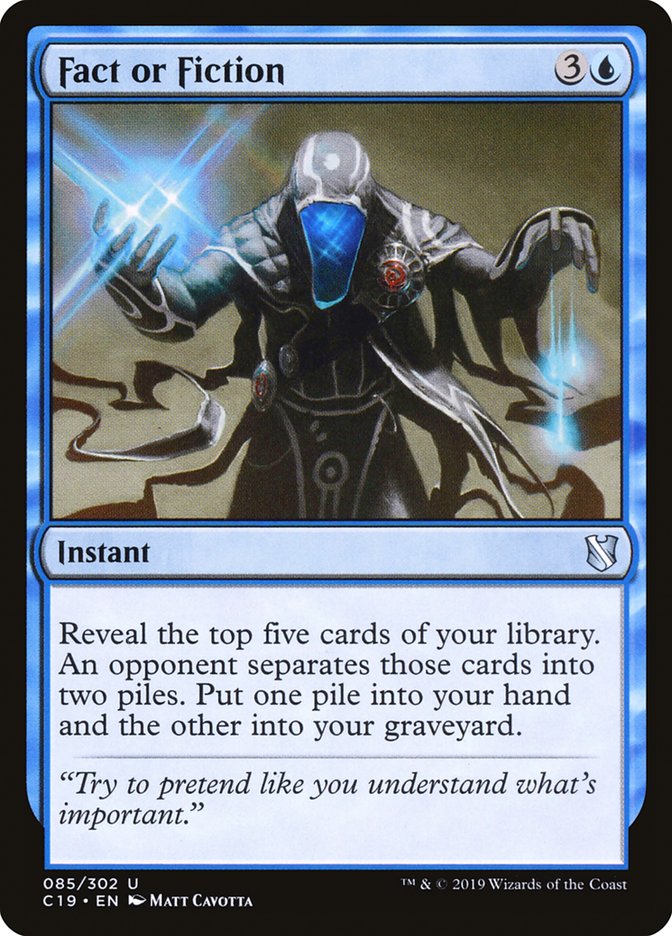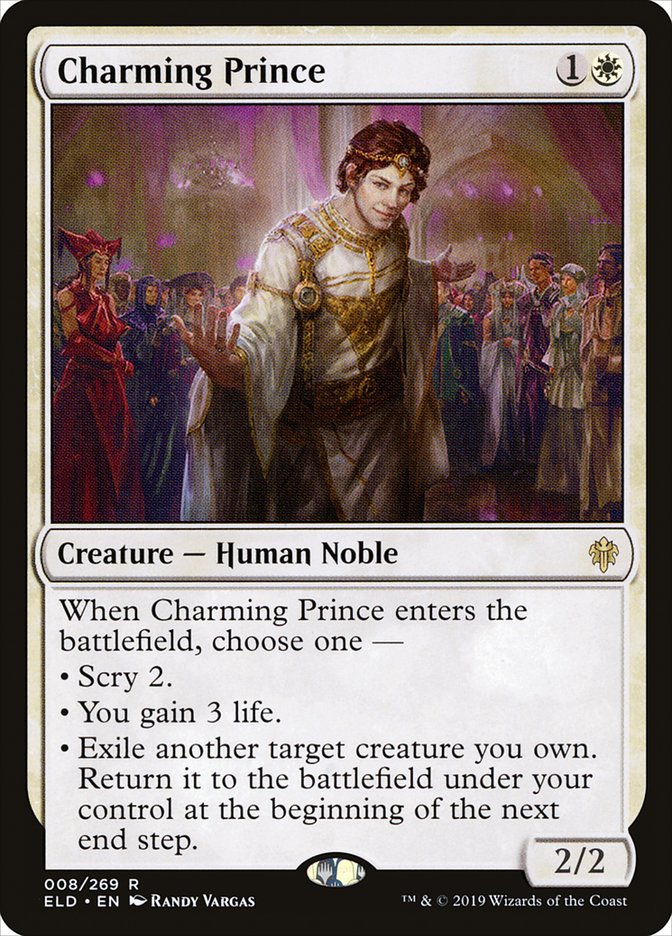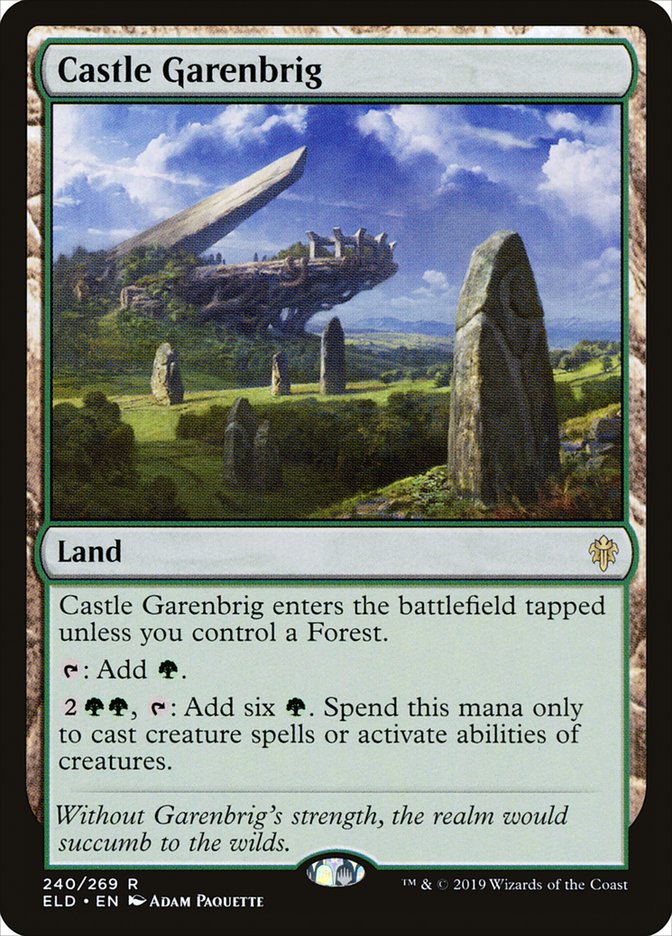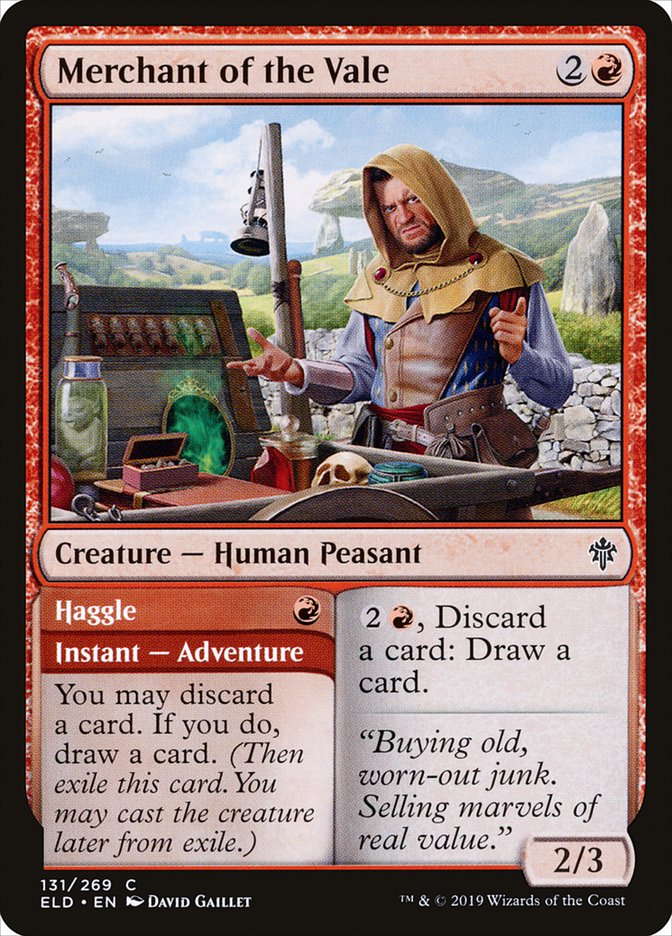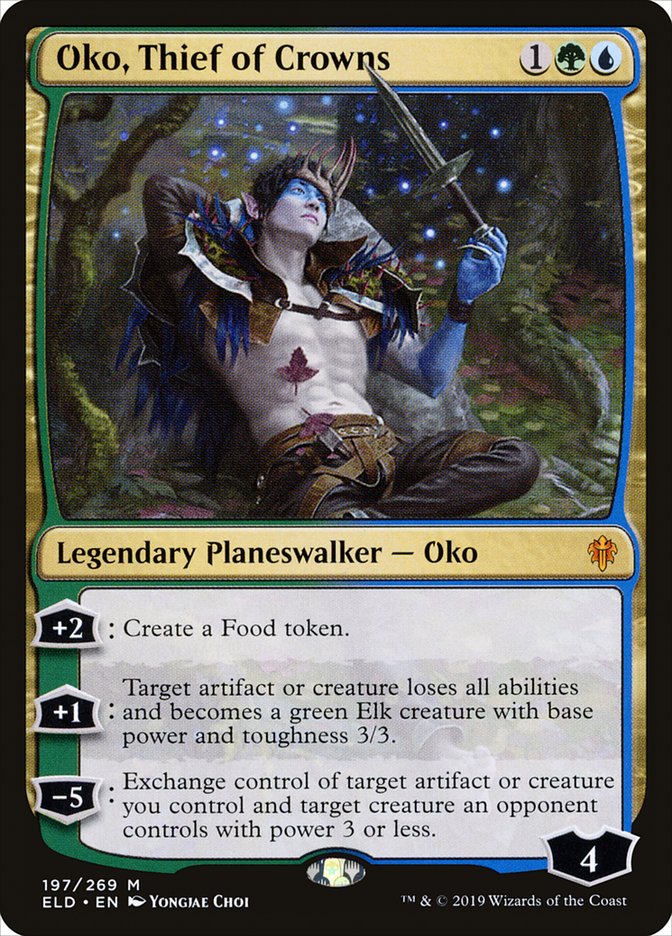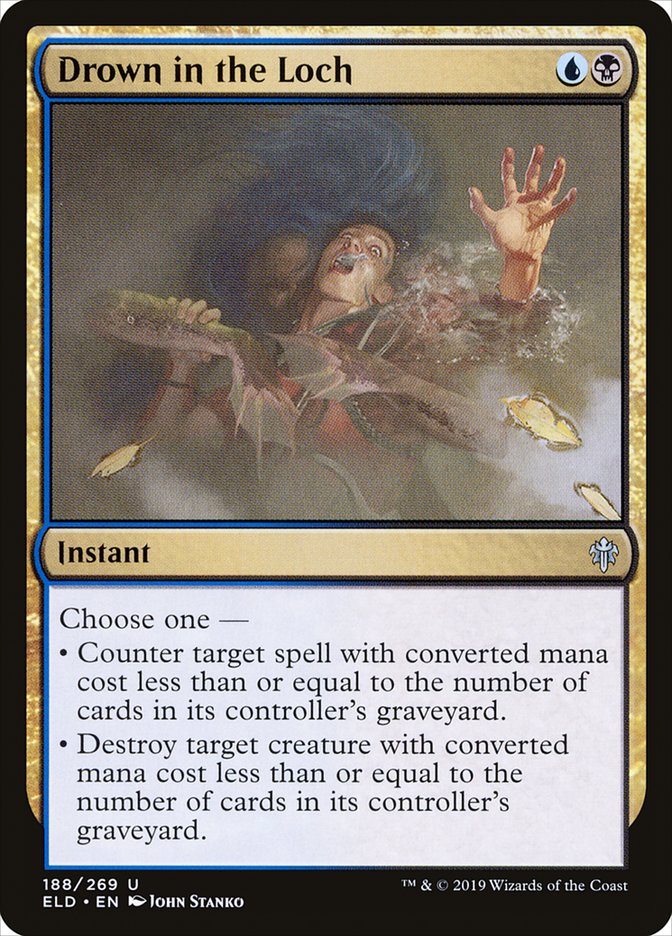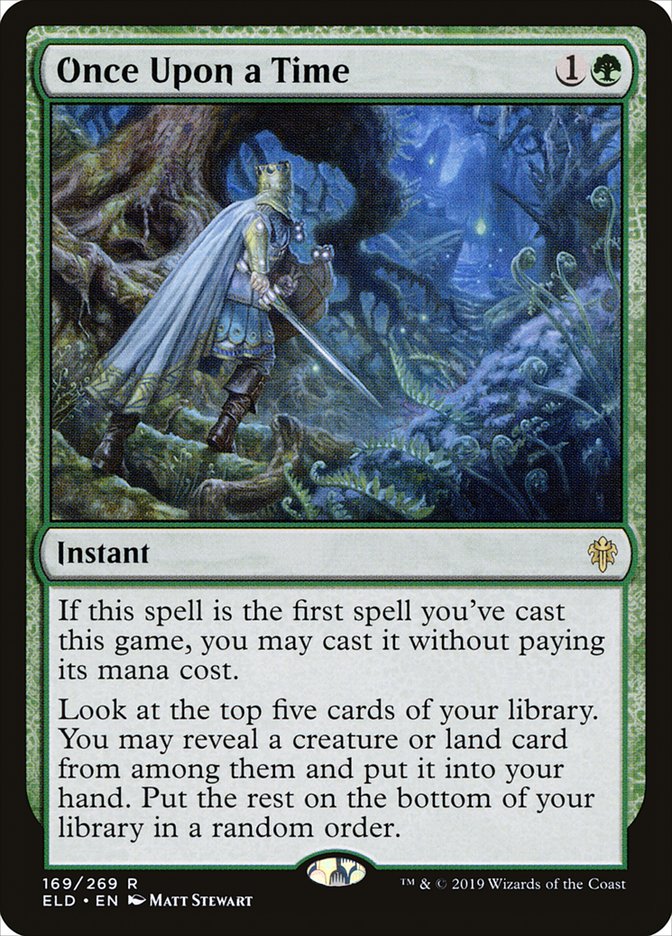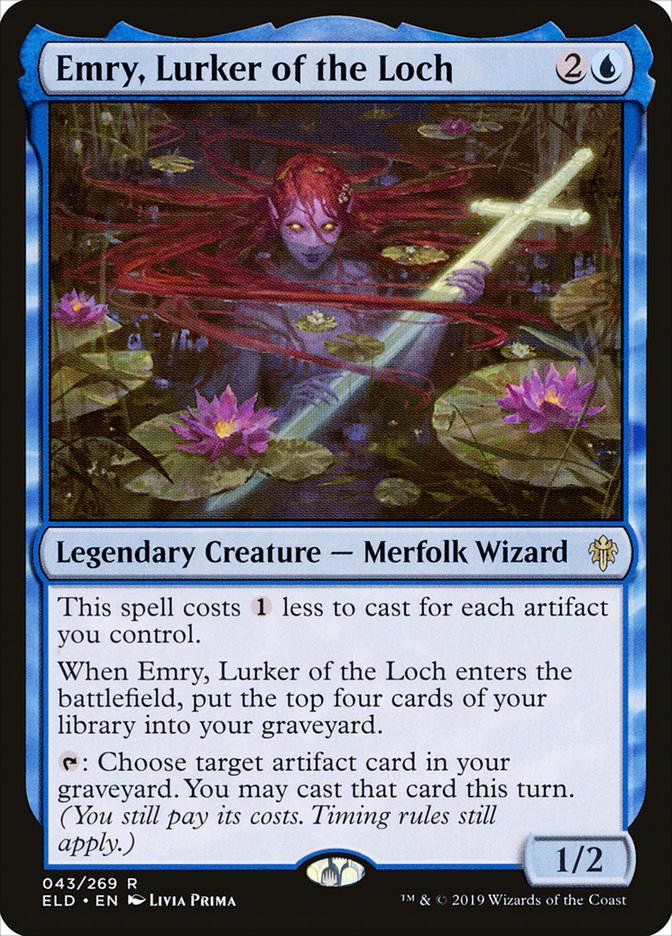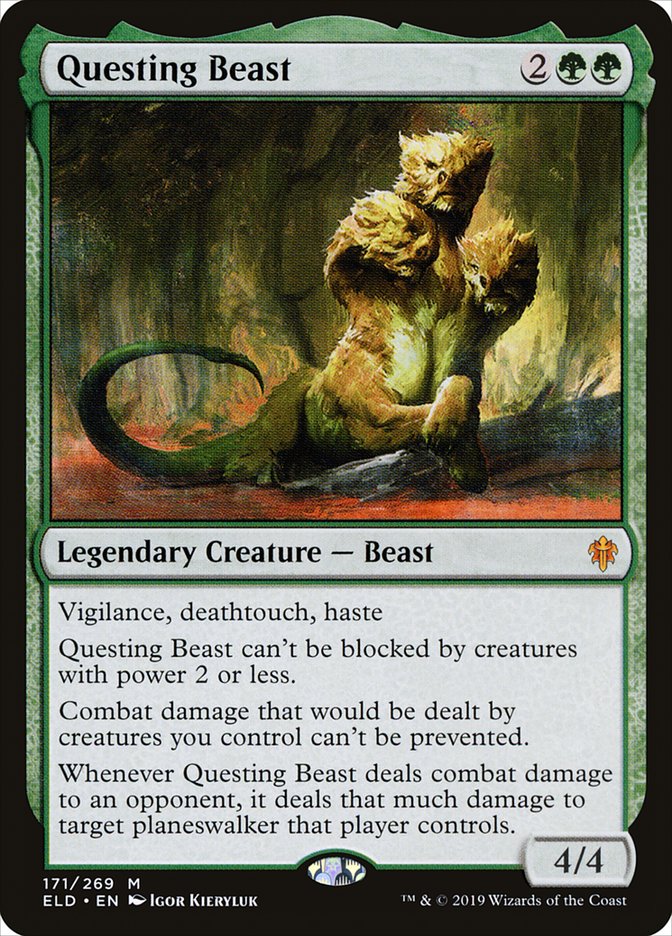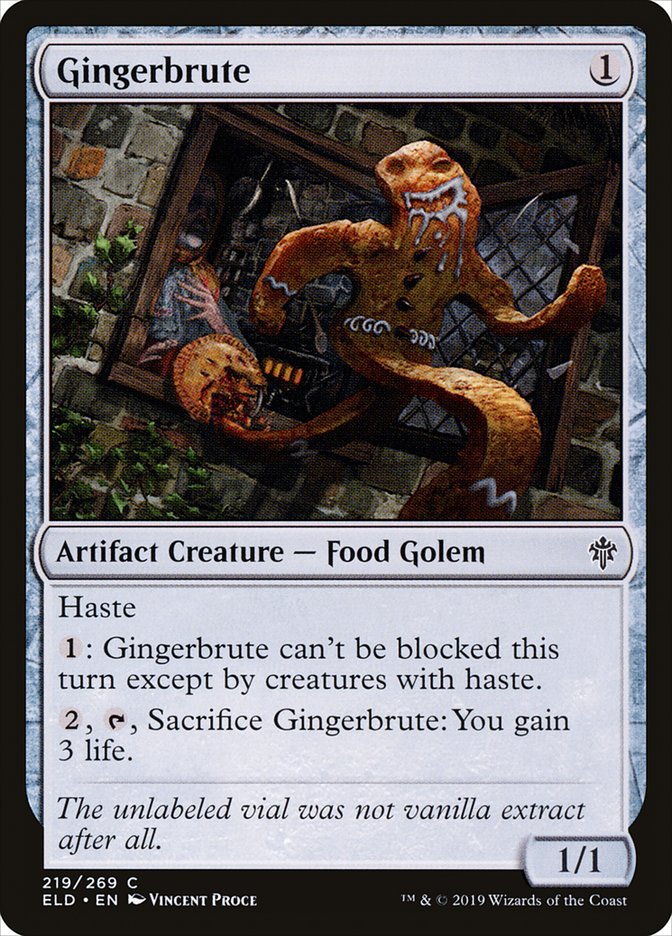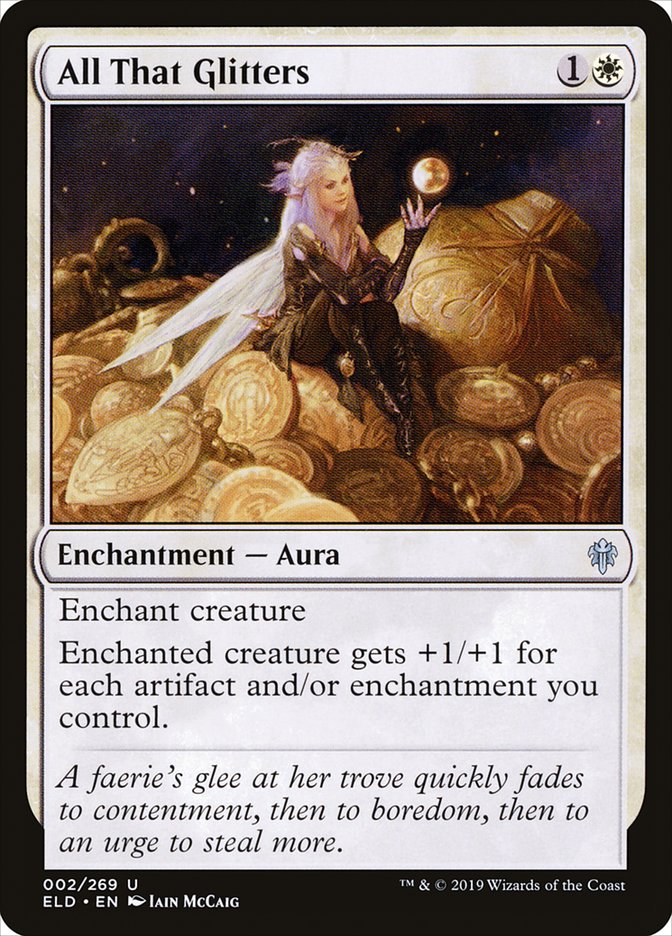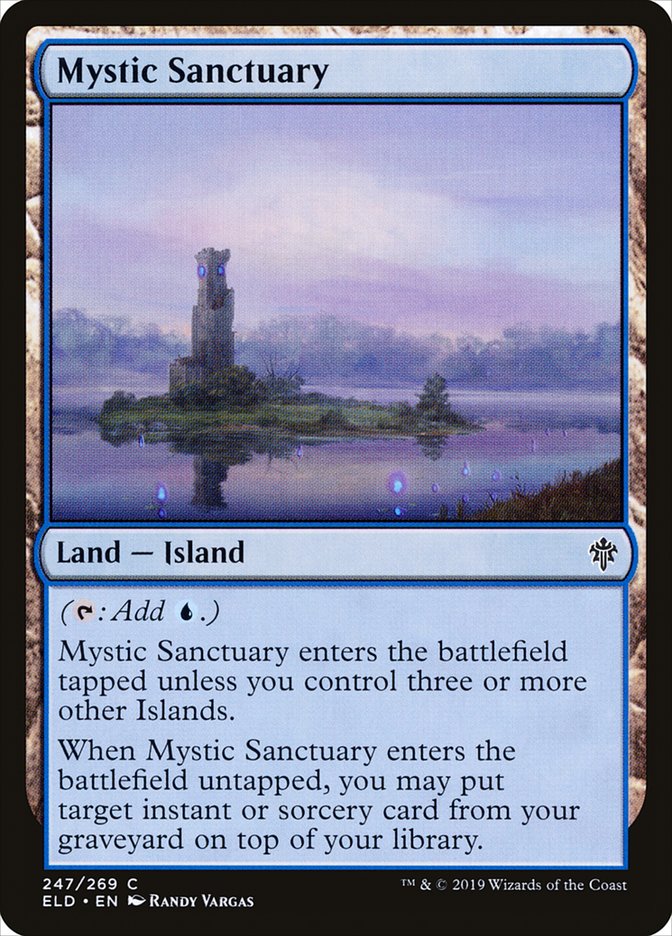Bryan Gottlieb shared his take on the Top 10 cards in Throne of Eldraine before the set was released. Having had time to play with the set across multiple formats and see some early results with Throne of Eldraine in Modern, I have a pretty different take on the Top 10 list, so I thought I’d share mine.
As it happens, I actually find it hard to choose only ten, as I think even adding all the cards on his Top 10 and my Top 10 lists (which, outside of disagreeing about ranking, include five different cards), I still don’t think we’ve covered all the playable Modern cards in the set. In the interest of keeping the countdown interesting, I’ll include some honorable mentions at the end, but first, let’s get to the Top 10.
10. Gilded Goose
It’s half Birds of Paradise, half Deathrite Shaman, but it’s the secret sprinkling of Thraben Inspector that really gets me into this card in Modern. In Throne of Eldraine Standard, players have found that Gilded Goose really doesn’t play like Birds of Paradise, in that they’re trying to go up the curve to cast cards like Nissa, Who Shakes the World, and finding that their Goose only offers easy mana once can be a little disappointing.
The card actually might play better in Modern, where curves are lower and you’re generally more interested in using this kind of creature to cast a three-mana spell on Turn 2, and considerably less invested in what happens after that. Also, there’s a lot more one-mana removal in Modern, which makes it less likely that a mana creature will live, and coming out ahead by an object can be a valuable asset over other mana creatures.
While it’s nice to be able to gain some life if your creature dies, that’s actually the less exciting use of the free Food token offered by Gilded Goose. What I’m interested in is the possibility of combining Gilded Goose with Mox Opal. Typically, decks that are looking to hit three mana on Turn 2 would like multiple cards that let them do so, but we’ve generally had the issue that while Mox Opal is the most powerful option, it doesn’t play well with cheap green creatures because it wants to use its early mana on artifacts to turn on Mox Opal. Meanwhile, playing multiple mana creatures can be a liability against sweepers. Mox Opal and Gilded Goose play extremely well together, as a draw consisting of both and a Mishra’s Bauble could allow you to cast Urza, Lord High Artificer on Turn 2, for example.
What might a deck that tries to take advantage of this look like?
Creatures (15)
Planeswalkers (6)
Lands (20)
Spells (19)

This deck isn’t as explosive as the Paradoxical Outcome versions; instead it’s more disruptive and has more angles of attack. This means that it has more play against opposing disruption and might play well in the Urza mirror, particularly as Urza is a creature with less than three power, meaning Oko, Thief of Crowns can trade to steal it.
9. Into the Story
Fact or Fiction has had kind of legendary status as the best four-mana instant-speed card draw spell, even though it doesn’t technically draw cards. It dominated its time in Standard, substantially aided by existing at a time with a lot of graveyard synergies, and then it didn’t happen to exist in Modern for most of Modern’s lifetime.
Fact or Fiction has nothing on Into the Story. Drawing four cards for four mana is incredible. People shy away from it because it looks too good to be true, and the seven-mana price tag is a little scary, but my experience has been that players almost always end up with large graveyards very quickly in Modern, and even in the rare games where that doesn’t happen, the kinds of decks that are looking for this effect are generally capable of hitting seven mana, so it still isn’t dead.
If this had been printed in another set, it would still be a fantastic card draw spell, but the fact that it came at the same time as Mystic Sanctuary means that I view this card as extremely important to the format, and think that it should essentially replace planeswalkers as the end-game in any true control decks in the format, unless those decks specifically look to avoid putting cards in their opponent’s graveyard (like if they lean on white removal and Rest in Peace), in which case they probably want to use Fact or Fiction or planeswalkers instead.
When I first decided to play the card, I thought there was a chance others would sleep on it early on, but aspiringspike on MTGO managed to showcase the card first with a 5-0 League result:
Creatures (8)
Lands (24)
Spells (28)

I think there’s a good chance my ranking of this card is too conservative, but I wanted to err toward being careful not to favor the cards I’ve personally been playing with too heavily.
8. Charming Prince
I don’t think this card is especially strong, but I do think it makes sense in Modern Humans, particularly because of the synergy with Aether Vial that allows it to protect another creature by blinking it at instant speed. It’s bad, but not horrible to have to cast just to Scry 2 when you need a threat, and access to maindeck lifegain is inarguably valuable against Burn. Ultimately, I think the comparison between this card and Unsettled Mariner is close, but it did already get the nod in the highest-finishing Humans deck in the Team Constructed Open in Philadelphia this weekend.
Creatures (37)
- 4 Meddling Mage
- 4 Noble Hierarch
- 2 Phantasmal Image
- 4 Champion of the Parish
- 4 Thalia, Guardian of Thraben
- 4 Mantis Rider
- 4 Reflector Mage
- 4 Thalia's Lieutenant
- 3 Kitesail Freebooter
- 1 Deputy of Detention
- 3 Charming Prince
Lands (19)
Spells (4)

Humans is currently far from enjoying its peak levels of success in Modern, but it’s not hard to imagine the format shifting in such a way that allows it to come back on top, especially if we end up seeing another banning or two, and that’s enough for me to give Charming Prince the eighth slot.
7. Castle Garenbrig
I wrote about this card when it was previewed and I still believe it’s good for the exact same reasons. Since then, it’s found its way into most successful Amulet Titan lists this past weekend, with players generally playing two copies, and has at least one Modern trophy on Magic Online in TitanShift. We haven’t seen the emergence of any new Primeval Titan decks built around it, but I’d never expect something like that to happen in the first weekend, especially with so many other powerful cards debuting at the same time.
There’s really not much to add about Castle Garenbrig, but this is it in the winning Modern deck from the Team Open in Philadelphia:
Creatures (13)
Lands (29)
- 2 Forest
- 2 Snow-Covered Forest
- 2 Gemstone Mine
- 1 Boros Garrison
- 1 Selesnya Sanctuary
- 1 Sunhome, Fortress of the Legion
- 2 Gruul Turf
- 2 Breeding Pool
- 1 Ghost Quarter
- 4 Simic Growth Chamber
- 1 Vesuva
- 3 Tolaria West
- 1 Bojuka Bog
- 1 Slayers' Stronghold
- 1 Cavern of Souls
- 1 Radiant Fountain
- 1 Field of the Dead
- 2 Castle Garenbrig
Spells (18)

6. Merchant of the Vale
We all know I’m really talking about Haggle. Bryan’s pick for this role was Thrill of Possibility, but I don’t believe what Modern needed wasn’t another two-mana version of the effect, even if it is at instant speed. We need it to happen at one mana, and this is a considerable upgrade over Insolent Neonate. It’s an instant, which is always an advantage, but in this case, it’s particularly advantageous for anyone who still wants to make Arclight Phoenix happen, but more importantly, you get both the Turn 1 rummage and the mediocre creature with this card, where you have to choose between them with Insolent Neonate.
The actual body on Merchant of the Vale is definitely nothing to write home about, but at the same time, it’s actually a card, by which I mean it will often be worth spending mana on and your opponent will often want to interact with it, since its ability lets you dredge more or do whatever you were trying to do with Haggle.
With Faithless Looting gone, at the very least, this card is the best in its class in Modern. If you want to get a card in your graveyard for one mana, this is the best way to do it, and that means a lot in a format as large as Modern. Whether Haggle is enough to make Dredge a good deck again is something of an open question, but here’s joker240sx’s list, which finished seventh in the Modern Challenge on Magic Online.
Creatures (22)
Lands (20)
Spells (18)
Sideboard

5. Oko, Thief of Crowns
When I made this list, I didn’t know what results Oko had put up this weekend; I just think it’s at least this good on the pure strength of the card (it should maybe swap to fourth on this list). I know there are some people who don’t think Oko’s the best three-mana planeswalker ever in Standard, but I still think it is, and I think it’s in the conversation for simply being the most powerful planeswalker ever printed.
Usually when a planeswalker makes a respectable body for its cost, it leaves you with a planeswalker that has very little remaining loyalty, but with Oko, if you have some trivial artifact around, like an Arcum’s Astrolabe, it essentially gives you a 3/3 haste creature and a planeswalker with five remaining loyalty on the battlefield. That’s an absurd amount of loyalty, and it gains loyalty, two loyalty, to give you another object. Sure, it’s not the best object, but it still taps for mana if you have Urza, Lord High Artificer, and it can still be exchanged to take control of your opponent’s Urza.
At the end of the day, I can do any amount of theorizing, and it won’t convince some people, so for those of you who prefer results, I offer that the second-place finisher of last weekend’s Open registered an entire playset of the card in his sideboard. Can you even remember the last time you saw four copies of a single planeswalker in a sideboard? I honestly can’t.
Creatures (10)
Planeswalkers (2)
Lands (18)
Spells (30)

4. Drown in the Loch
This one doesn’t have the same high-profile results that the other cards at the top of the list do, but I believe that’s just because it doesn’t slot as cleanly into existing decks. I still firmly believe that Thrones of Eldraine largely brings a new era of Modern, and the results we’re seeing are mostly a holdover from pre-Eldraine Modern.
Drown in the Loch is an absurd card. I played four copies over eight rounds of Modern last weekend and there were very few moments when it functioned differently from it would have read “Counter target spell or destroy target creature.” I’m not arguing that it’s exactly that, or that it doesn’t require any work, but a card that literally did that would be so far above the rate we’re used to seeing for interaction that if Drown in the Loch doesn’t do what you want 10% of the time, it’s still among the best two-mana interactive spells in Modern, which is precisely how I rate it.
Here’s the deck I played that took advantage of it:
Creatures (5)
Lands (23)
Spells (32)

3. Once Upon a Time
Now we’re getting into the real powerhouses. Once Upon a Time is an absolute slam dunk in Amulet Titan and also saw success in Mono-Green Tron this weekend, and I doubt anyone thinks that it will be limited to big mana strategies. It showed up in the Team Constructed Open in Traverse Death’s Shadow, and I like it there. I’m surprised that it didn’t make an appearance in Infect, where I expect it to be adopted soon. A lot of decks use green mana and creatures to try to play short games of Magic, and most of those decks should be using Once Upon a Time.
The card has such widespread applications that even listing a single deck in particular to attribute it to feels like it misses the point. One can make a reasonable case that this card compares favorably to Ancient Stirrings, which is a card people have discussed banning for years. That’s crazy.
2. Emry, Lurker of the Loch
To get ahead of a card with applications as widespread as Once Upon a Time, a card has to be really impressively powerful, and I believe Emry, Lurker of the Loch meets that bar. While I’m personally skeptical of going as far as adding Jeskai Ascendancy to Urza decks, I’ve already heard several complaints about losing on Turn 2 to Emry plus Jeskai Ascendancy.
Even without going that extreme, all three teams that finished in the Top 8 of the Team Constructed Open that played Urza, Lord High Artificer played a full playset of Emry, Lurker of the Loch, which represents impressive adoption and success rates. This card will generally cost a single mana, offer a bit of a toolbox, and then threaten to essentially draw a card every turn for no mana if unanswered. How many one-mana creatures come even close to comparing with that? Deathrite Shaman maybe? This card is incredible.
Honorable Mentions
Two of my opponents last weekend cast Questing Beast, and one noted that it had served him well throughout the day. I’m skeptical of this kind of thing in Modern, but it has substantially exceeded my expectations in Standard, so I think it has some chance in Modern. The Castle cycle in general has some chance, but I’m particularly interested in Castle Locthwain in both Death’s Shadow decks of any sort and 8-Rack-style decks.
Finally, I must point out the pair of Gingerbrute and All That Glitters as bringing about a potentially new kind of Affinity deck, and Gingerbrute can stand on its own just off the strength of Cranial Plating.
1. Mystic Sanctuary
Playing with it this weekend only strengthened by position since I wrote about it last week. I still expect that Mystic Sanctuary will revolutionize Modern, and I don’t think this card is reasonable in any way. I’d say that I expect it to be banned in the next year, except that I’m not sure that what it does is in Modern is unhealthy; it’s just very, very different.
Mystic Sanctuary has two primary applications. The first is essentially to protect an essential Sorcery or Instant from discard, for example, Urza Outcome can play one, as Josh McClain did, to find Paradoxical Outcome if the opponent takes it with Thoughtseize. Alternatively, you can play multiple copies of the card and use it to create a toolbox end-game where you get to pick which spell you draw whenever you have a fetchland, which is what my Sultai deck is built to do.
This has been compared to adding a free Mystical Tutor to every fetchland starting on Turn 4, and while it doesn’t quite do that, because it can’t find a card you haven’t already gotten out of your library, it actually does so much more than that. The extent to which or way in which recurring a card is more powerful than tutoring for a card is often overlooked, but it’s really highlighted with Mystic Sanctuary, because it allows you to cast the same spell several times even if you only have a single copy in your deck. This is particularly pronounced with Deprive and Cryptic Command, which allow you to pick up your Mystic Sanctuary, so that you can cast either any number of times.
I won my very first game, and my second game of the event I played this weekend by locking my Selesnya Hexproof opponent out by looping two Cryptic Commands with Mystic Sanctuary.
Mystical Tutor doesn’t do anything like that.


